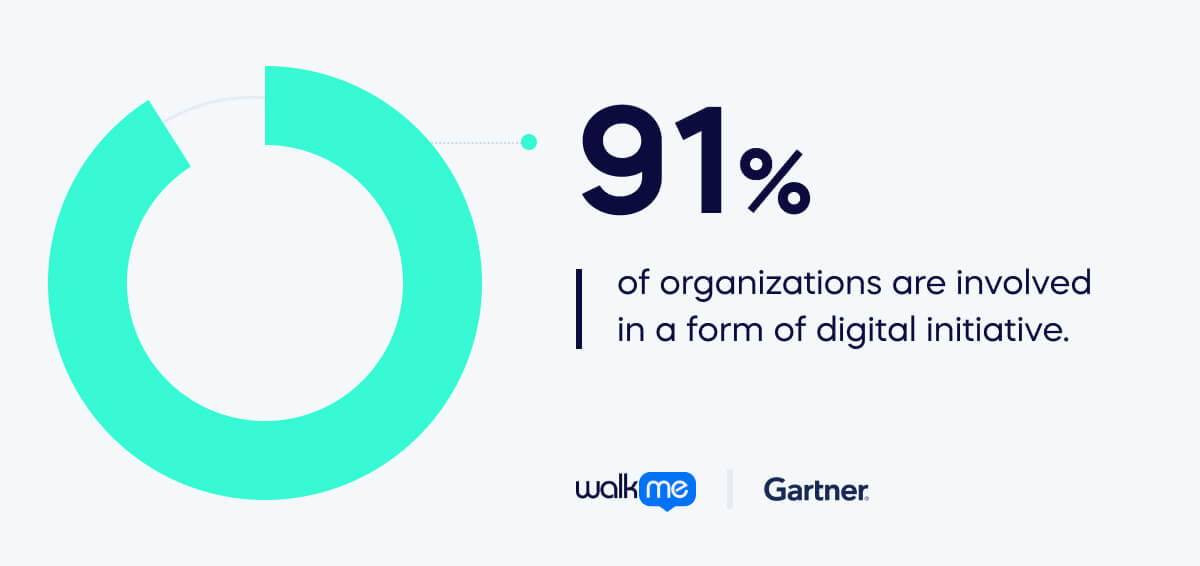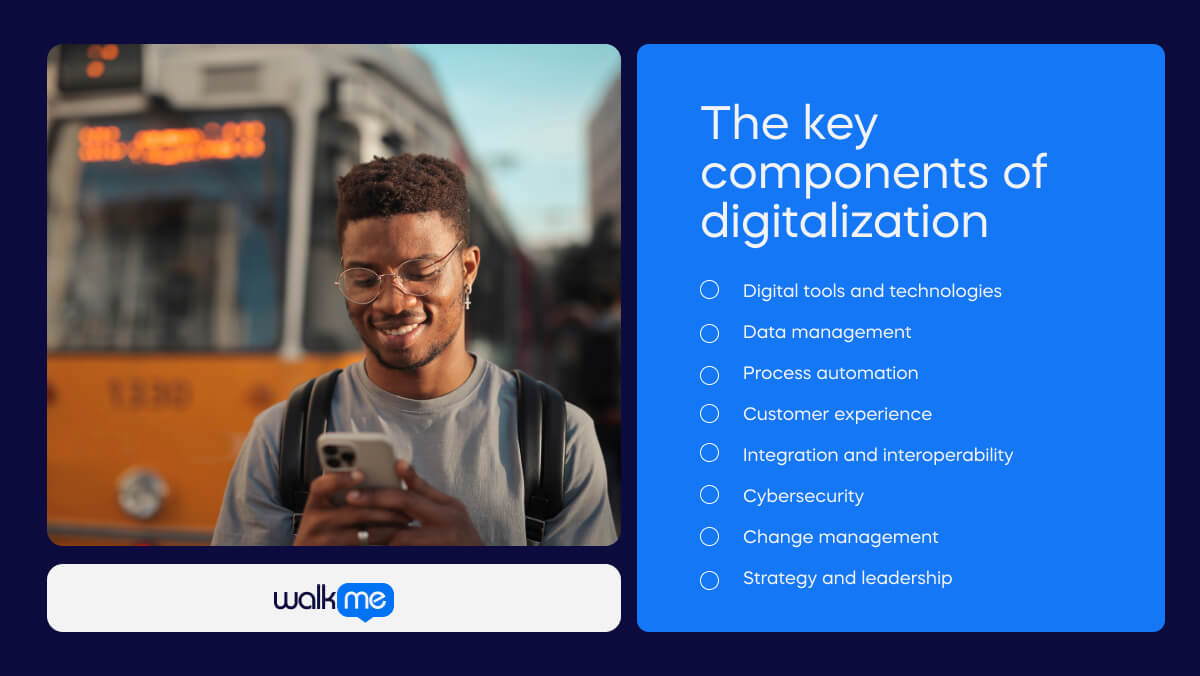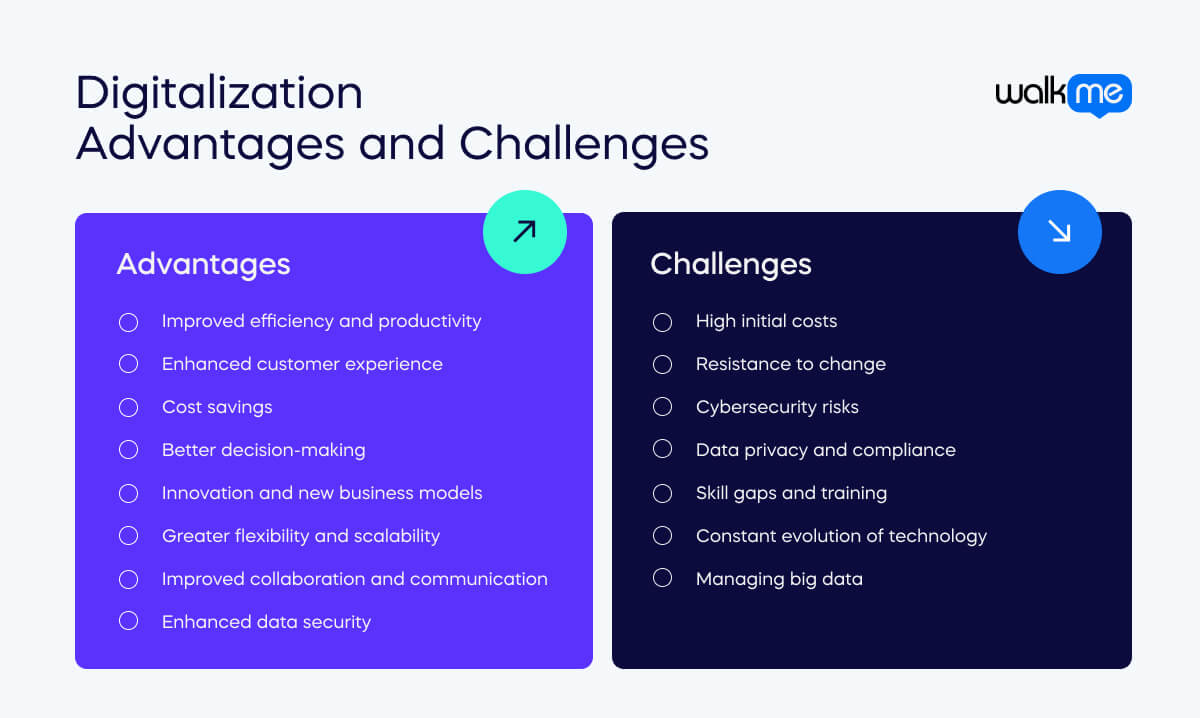What is digitalization?
Digitalization is the use of digital technologies in business to transform how organizations work and deliver value to customers. It involves using digital tools to boost efficiency, streamline workflows, and encourage digital innovation.

Table of contents
Companies can use cloud transformation, data analytics, and the IoT to optimize operations, cut costs, and improve services. One key aspect of digitalization is process improvement. Digital tools automate routine tasks. This boosts efficiency and cuts errors. For instance, automated data entry systems reduce manual input. They speed up operations and improve accuracy. Digitalization also improves decision-making. It provides real-time data and insights, allowing businesses to respond quickly to market changes and customer needs. Moreover, digitalization enhances customer experience by offering personalized services and multi-channel engagement.
Digital platforms, like mobile apps and websites, give customers easy access to services and support. This connectivity boosts collaboration and communication within and between organizations, creating a more cohesive and responsive business environment. Digitalization is a strategic approach that leverages digital technologies to transform business processes, improve efficiency, and deliver enhanced value to customers. It drives overall business growth and competitiveness in the digital age.

Digitalization is increasingly important. Statistics reveal that global digital transformation spending will reach 3.9 trillion US dollars by 2027. Furthermore, Gartner shows that 91% of organizations are involved in a form of digital initiative.
What are the key components of digitalization?

Digitalization comprises several key components. Together, they transform business processes and operations. Focusing on these elements can make organizations more efficient, foster innovation, and stay competitive in a fast-changing digital world. These components include:
Digital tools and technologies
Digitalization requires advanced technologies, including cloud computing, big data analytics, AI, machine learning, and the IoT. These technologies use software like CRM, ERP, and collaboration tools.
Data management
Effective data management is crucial for digitalization. It includes collecting, storing, and analyzing data, which drives decisions and improves processes. Ensuring data accuracy, security, and compliance with relevant regulations is also essential.
Process automation
Automating routine tasks boosts efficiency, cuts errors, and frees up people for more strategic work. Examples include automated data entry, robotic process automation, and streamlined workflows.
Customer experience
A key part of digitalization is improving customer interactions. This means using digital channels like mobile apps, websites, and social media. Personalizing services and providing real-time support improves customer satisfaction and engagement.
Integration and interoperability
A seamless integration of various digital tools creates a strong, efficient ecosystem. Connecting different platforms and departments is vital for smooth operations, enabling communication and data exchange.
Cybersecurity
Implementing robust security measures protects digital assets, data, and infrastructure from cyber threats. Regular updates, monitoring, and compliance with security standards and protocols ensure ongoing protection.
Change management
Digitalization requires a shift in the organization and its culture. To succeed, training and supporting employees in using new digital tools and processes is important. Fostering a culture of continuous improvement and innovation is vital.
Strategy and leadership
A clear digital strategy aligned with overall business goals is essential. Leadership commitment drives digital initiatives and allocates necessary resources. It’s also crucial to assess and adapt the strategy based on evolving technologies and market conditions.
Digitalization vs digitization
Don’t confuse digitalization for digitization. Though often used interchangeably, they’re different.
- Digitization is simply converting hard/paper files and documents into digital files and documents.
- Digitalization is the strategy or process of utilizing digital technologies, resulting in deeper changes that can alter the core of business models.
Let’s take a closer look at the two terms.
| Digitalization | Digitization | |
| Definition | Refers to using digital technologies to change and improve business processes and operations. It means using digital tools in an organization to boost efficiency, productivity, and value. | The process of converting analog information into a digital format. It usually involves scanning, encoding, or transforming physical data. This includes paper documents, photos, and audio recordings. The goal is to make a digital form that computers can easily store, access, and process. |
| Focus | Transforming business processes through the adoption of digital technologies. The aim is to optimize and innovate processes, enhance customer experiences, and create new business models. | The conversion of analog data into digital form. The primary concern is to preserve the integrity of the original information while making it accessible in a digital format. |
| Techniques | Implementing digital tools and platforms such as: CRM systems, ERP systems, Cloud computing, Artificial intelligence The Internet of Things | Scanning documents to create PDFs Converting analog audio to MP3 files Digitizing photographs or film |
| Goals | Aims to improve business efficiency, enhance customer experiences, foster innovation, and create new revenue streams. The goal is to transform the way an organization operates and competes in the market by leveraging digital technologies. | Aims to make information more accessible, easier to share, and less vulnerable to physical degradation. The goal is to ensure that data is preserved and can be easily retrieved and used in digital systems. |
| Examples of use | Using a CRM system to manage customer interactions and improve sales processes Implementing an ERP system to streamline supply chain management Adopting AI-powered analytics to gain insights from large datasets and drive strategic decision-making. Utilizing IoT devices to monitor and optimize manufacturing processes in real-time | Scanning historical records to create a digital archive Converting paper-based patient records into electronic health records Digitizing old films and music for preservation and online distribution. |
Use cases for digitalization
Digitalization appears in various business settings, impacting sectors from retail and healthcare to manufacturing. We will see how digital tools and strategies enhance efficiency, improve customer experiences, and drive innovation across these industries by examining specific examples.
Omnichannel retail strategy
Let’s look at a retail example where combining online and offline sales channels creates a seamless shopping experience. Integrating these platforms allows customers to easily browse products online, check in-store availability, and purchase through a mobile app. This flexibility caters to individual preferences, offering home delivery or in-store pickup options. Retailers also leverage data analytics to personalize marketing efforts, tailoring product recommendations based on customer behavior and preferences. This approach enhances the overall shopping experience while helping retailers manage inventory more effectively. It ensures that the right products are available when and where they are needed. Retailers can strengthen customer relationships and optimize their overall operations through this blend of digital and physical channels.
Electronic Health Records (EHR)
Consider how digitalization transforms healthcare by enhancing patient care and operational efficiency. Electronic Health Records (EHRs) allow healthcare providers to quickly and accurately access comprehensive patient histories, facilitating more informed and timely decision-making. Telemedicine platforms further extend the reach of care by enabling remote consultations. This allows patients to receive medical advice and treatment without the need for in-person clinic visits. This convenience is especially valuable for those with limited mobility or those living in remote areas. Additionally, integrating wearable health devices into healthcare systems enables real-time monitoring of patient vitals. These devices provide doctors with continuous, actionable data, crucial for managing chronic conditions and enabling prompt interventions when necessary. Healthcare providers can offer more personalized and responsive care through these digital innovations, improving outcomes and enhancing the overall patient experience.
Smart factories in the manufacturing industry
Digitalization in manufacturing paves the way for the development of smart factories, where IoT sensors and devices play a crucial role in monitoring machinery and production processes in real-time. These advanced systems enable predictive maintenance, allowing manufacturers to analyze sensor data to foresee and address equipment failures before they happen, significantly reducing downtime and maintenance costs. Integrating advanced robotics and automation further enhances production lines, boosting efficiency and precision.
Another key innovation is digital twins—virtual replicas of physical assets—which allow manufacturers to simulate and optimize processes before implementing changes in the real world. This approach improves productivity and minimizes waste, making the entire manufacturing process more sustainable and cost-effective. Through these technologies, digitalization transforms traditional manufacturing into a highly efficient, data-driven operation that can quickly adapt to evolving demands.

What are the advantages of digitalization?
Digitalization has many benefits. It improves efficiency and productivity in various sectors, boosting overall business performance. Rolling out a digitalization strategy better positions companies for future challenges and opportunities. Let’s take a closer look at the key advantages:
Improved efficiency and productivity
Digitalization automates routine tasks, reducing the need for manual intervention and minimizing errors. This leads to faster, more efficient workflows, allowing employees to focus on more strategic, value-added tasks.
Enhanced customer experience
Businesses can use digital tools like CRM systems and apps to give customers a seamless, personalized experience. Real-time support, custom recommendations, and easy access boost customer satisfaction and loyalty.
Cost savings
Automating processes and optimizing resource use can significantly reduce operational costs. Digitalization improves inventory management and reduces waste. It also boosts supply chain efficiency. These benefits cut costs.
Better decision-making
Digitalization facilitates the collection and analysis of large amounts of data. Businesses can use advanced analytics and AI to gain insights, predict trends, and make data-driven decisions. This can improve their strategic planning and competitiveness.
Innovation and new business models
Digital technologies boost innovation. They enable new business models and revenue streams. Examples are subscription services, e-commerce sites, and digital products. They were not feasible in a traditional setup.
Greater flexibility and scalability
Digital tools and cloud solutions are flexible and scalable. They let businesses adapt to market changes and adjust operations as needed. This agility is crucial for staying competitive in a dynamic business environment.
Improved collaboration and communication
Digital platforms facilitate better communication and collaboration within and across organizations. Tools like project management software and video conferencing help teams work together, no matter where they are. Collaborative workspaces also help.
Enhanced data security
Digitalization includes strong cybersecurity to protect sensitive data from breaches and threats. Advanced encryption, authentication, and monitoring systems help ensure data integrity. They also ensure compliance with regulations.
What are the challenges of digitalization?
Digitalization has many benefits, but it also poses challenges. Businesses must navigate these to implement digitalization successfully. Addressing these challenges requires a strategic approach. Careful planning and ongoing commitment are needed. This will ensure that digitalization efforts lead to lasting success and growth. Here are some key challenges:
High initial costs
Implementing digital technologies often requires significant upfront investment in hardware, software, and infrastructure. These costs can be a barrier, especially for small and medium-sized enterprises (SMEs).
Resistance to change
Employees and management may resist digitalization. They fear job loss, don’t understand it, or are uncomfortable with new technology. Overcoming this resistance requires effective change management strategies and training programs.
Cybersecurity risks
As businesses use more digital tools, they become more vulnerable to cyber threats like hacking, data breaches, and malware. Ensuring robust cybersecurity measures is crucial but can be complex and costly.
Data privacy and compliance
Handling large data volumes raises concerns about privacy and compliance with GDPR, HIPAA, and CCPA. Businesses must have the right policies and technology to protect sensitive data and meet legal requirements.
Skill gaps and training
Digitalization demands new skills and expertise that existing staff may not possess. Organizations must train and upskill employees or hire new talent. But, this can be time-consuming and costly.
Constant evolution of technology
Businesses must adapt to new tools and trends. Technology is advancing fast. Keeping up with these changes requires ongoing investment and can lead to the obsolescence of current systems.
Managing big data
While data is a valuable asset, managing and analyzing large volumes of data can be overwhelming. Businesses must use effective data management tools. They need to find insights without being overwhelmed by complex data.
How can DAPs help with digitalization?
Digital adoption platforms (DAPs) can help with digitalization. They assist organizations in using new digital tools and technologies. They can greatly speed up digitalization by improving training, increasing user adoption, providing ongoing support, and offering insights into usage and effectiveness. This results in a more efficient, productive, and digitally adept organization. Here are several ways DAPs can support digitalization:
Streamlined onboarding and training
DAPs provide step-by-step guides and interactive tutorials. They help employees quickly learn new software and digital tools, reducing the time and effort needed for training and accelerating the onboarding process.
Enhanced user experience
DAPs boost user experience by providing in-app help and support. Users get help when and where they need it, reducing frustration and boosting productivity.
Increased adoption rates
DAPs help ensure that employees fully utilize the features of new digital tools. They also boost technology adoption by giving users constant support, which leads to higher usage and better ROI.
Data-driven insights
DAPs collect data on users’ interactions with digital tools. They provide insights into usage patterns, pain points, and areas for improvement. Organizations can use this data to improve their digital strategies. It will make their digitalization efforts more effective.
Improved compliance and security
DAPs help maintain compliance with internal policies and external rules by guiding users through proper procedures and best practices. This reduces the risk of errors and enhances overall security.
Accelerated ROI
DAPs help organizations quickly reap the benefits of digitalization. They do this by speeding up the adoption of digital tools and ensuring their effective use. This leads to faster returns on investment and greater overall efficiency.